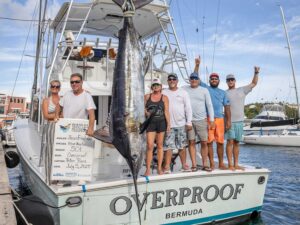
MAR0914_BWC_Dolphin-1a
A new chapter in the Dolphinfish Research Program’s study of the dolphin’s life history using satellite tags was initiated recently off South Carolina. Two of the high-tech instruments were deployed off Charleston on June 3 to begin a long-term tracking study of this important game fish. One of the study’s goals is to document the routes dolphin use when they leave the U.S. Atlantic coast to head south for the winter.
Thanks to the invitation by Hunter Edwards, owner of the sport-fishing vessel My Three Sons, I was able to join him and his friends for a day of offshore fishing.
Captained by Michael Mattson, the trip was intended to be a fun day of fishing off Charleston, South Carolina, with hopes of deploying a satellite tag on a dolphin. The trip started with a bang, with the very first bait in the water resulting in the release of a white marlin, followed quickly by a pair of dolphin in the box. With six to eight dolphin in the box, a nice 40-inch bull dolphin was brought to the boat, netted, and boated for the satellite tag to be attached. By 9:45 a.m., the first satellite tag was deployed. Less than three hours later, a second bull dolphin would be fitted with a satellite tag and released.
These fish were tagged 66 miles southeast of Charleston, well out into the Gulf Stream. Because they were released in the main flow of the current, it is hoped that they will speed along on their way to North Carolina and points north, avoiding fish hooks and other predators along the way. Previous experiences of tracking dolphin with these devices have shown that it is difficult to have a fish carry the mini computer for 30 days. Only 28 percent of the fish carrying satellite tags survived predation for periods of three weeks or more. Now we are looking for that miracle fish that can survive for six months following tagging.
This research study has been made possible by a grant from the Guy Harvey Ocean Foundation. Many might not be aware that Harvey holds a Ph.D. and is a marine scientist who is very active in fisheries research. He regularly utilizes satellite tags in several of his shark studies.
Dr. Harvey’s generosity has allowed the DRP to purchase five satellite tags, along with funds for the satellite time to recover the data. This permits the DRP to begin one of its most ambitious studies: tracking the movement routes used by South Carolina dolphin for up to six months following their release.
Information gathered from conventional tags has mapped out the domestic routes used by dolphin traveling along the U.S. Atlantic coast. It is when they turn east and southeast departing the U.S. Mid-Atlantic Bight that their travel routes become a mystery. By programming these instruments to remain with the fish for 180 days, we hope that the fish will be well out into the Sargasso Sea, if not approaching the northeastern Caribbean Islands, when the instruments release from the fish to begin transmitting their information.
— Don Hammond, Director Dolphinfish Research Program Cooperative Science Services, LLC, dolphintagging.com








